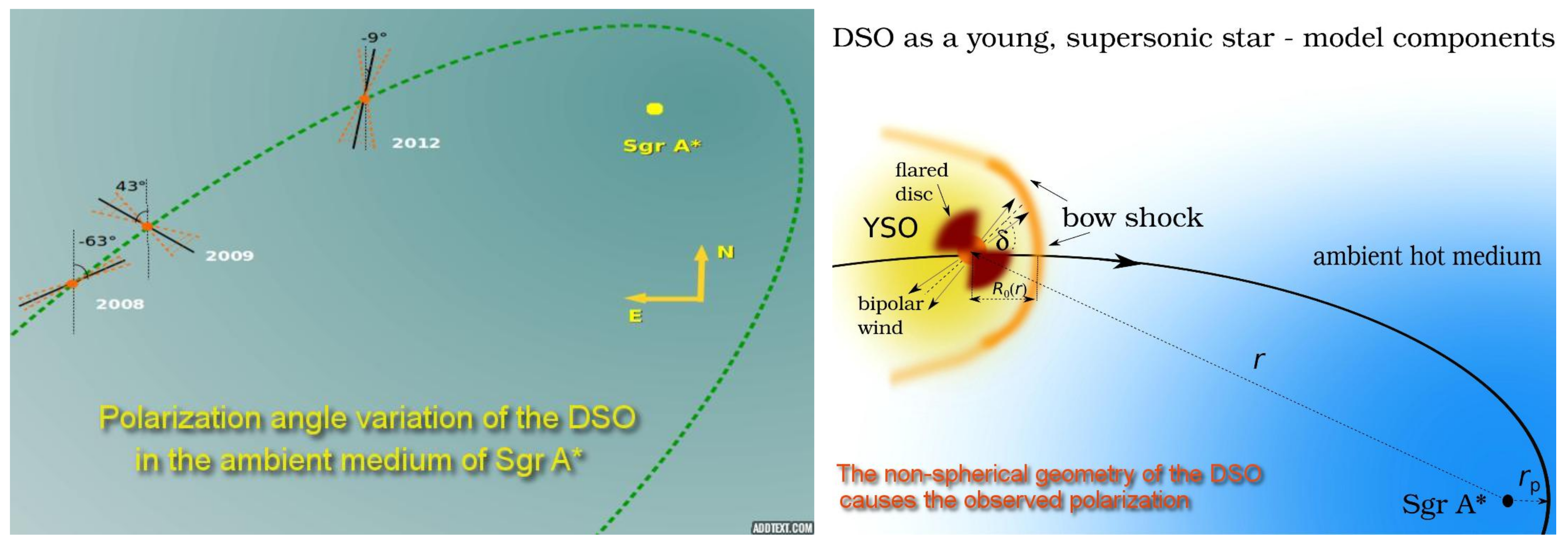Polarization: A Method to Reveal the True Nature of the Dusty S-Cluster Object (DSO/G2)
Abstract
:1. Introduction
2. Analysis and Results
Acknowledgments
Author Contributions
Conflicts of Interest
References
- Eckart, A.; Genzel, R. Observations of stellar proper motions near the Galactic Centre. Nature 1996, 383, 415–417. [Google Scholar] [CrossRef]
- Eckart, A.; Genzel, R. Stellar proper motions in the central 0.1 PC of the Galaxy. Mon. Not. R. Astron. Soc. 1997, 284, 576–598. [Google Scholar] [CrossRef]
- Eckart, A.; Hüttemann, A.; Kiefer, C.; Britzen, S.; Zajaček, M.; Lämmerzahl, C.; Stöckler, M.; Valencia-S., M.; Karas, V.; García-Marín, M. The Milky Way’s Supermassive Black Hole: How Good a Case Is It? Found. Phys. 2017, 47, 553–624. [Google Scholar] [CrossRef]
- Parsa, M.; Eckart, A.; Shahzamanian, B.; Karas, V.; Zajaček, M.; Zensus, J.A.; Straubmeier, C. Investigating the Relativistic Motion of the Stars Near the Supermassive Black Hole in the Galactic Center. Astrophys. J. 2017, 845, 22. [Google Scholar] [CrossRef]
- Gillessen, S.; Genzel, R.; Fritz, T.K.; Quataert, E.; Alig, C.; Burkert, A.; Cuadra, J.; Eisenhauer, F.; Pfuhl, O.; Dodds-Eden, K.; et al. A gas cloud on its way towards the supermassive black hole at the Galactic Centre. Nature 2012, 481, 51–54. [Google Scholar] [CrossRef] [PubMed]
- Eckart, A.; Mužić, K.; Yazici, S.; Sabha, N.; Shahzamanian, B.; Witzel, G.; Moser, L.; Garcia-Marin, M.; Valencia-S., M.; Jalali, B.; et al. Near-infrared proper motions and spectroscopy of infrared excess sources at the Galactic center. Astron. Astrophys. 2013, 551, A18. [Google Scholar] [CrossRef]
- Zajaček, M.; Britzen, S.; Eckart, A.; Shahzamanian, B.; Busch, G.; Karas, V.; Parsa, M.; Peissker, F.; Dovčiak, M.; Subroweit, M.; et al. Nature of the Galactic centre NIR-excess sources. I. What can we learn from the continuum observations of the DSO/G2 source? Astron. Astrophys. 2017, 602, A121. [Google Scholar] [CrossRef]
- Valencia-S., M.; Eckart, A.; Zajaპk, M.; Peissker, F.; Parsa, M.; Grosso, N.; Mossoux, E.; Porquet, D.; Jalali, B.; Karas, V.; et al. Monitoring the Dusty S-cluster Object (DSO/G2) on its Orbit toward the Galactic Center Black Hole. Astrophys. J. 2015, 800, 125. [Google Scholar] [CrossRef]
- Shahzamanian, B.; Eckart, A.; Zajaček, M.; Valencia-S., M.; Sabha, N.; Moser, L.; Parsa, M.; Peissker, F.; Straubmeier, C. Polarized near-infrared light of the Dusty S-cluster Object (DSO/G2) at the Galactic center. Astron. Astrophys. 2016, 593, A131. [Google Scholar] [CrossRef]
- Zajaček, M.; Eckart, A.; Karas, V.; Kunneriath, D.; Shahzamanian, B.; Sabha, N.; Mužić, K.; Valencia-S., M. Effect of an isotropic outflow from the Galactic Centre on the bow-shock evolution along the orbit. Mon. Not. R. Astron. Soc. 2016, 455, 1257–1274. [Google Scholar] [CrossRef]
- Robitaille, T.P. HYPERION: An open-source parallelized three-dimensional dust continuum radiative transfer code. Astron. Astrophys. 2011, 536, A79. [Google Scholar] [CrossRef]
- Witzel, G.; Ghez, A.M.; Morris, M.R.; Sitarski, B.N.; Boehle, A.; Naoz, S.; Campbell, R.; Becklin, E.E.; Canalizo, G.; Chappell, S.; et al. Detection of Galactic Center Source G2 at 3.8 μm during Periapse Passage. Astrophys. J. Lett. 2014, 796, L8. [Google Scholar] [CrossRef]
- Shahzamanian, B.; Eckart, A.; Valencia-S., M.; Witzel, G.; Zamaninasab, M.; Sabha, N.; García-Marín, M.; Karas, V.; Karssen, G.D.; Borkar, A.; et al. Polarized light from Sagittarius A* in the near-infrared Ks-band. Astron. Astrophys. 2015, 576, A20. [Google Scholar] [CrossRef]
- Shahzamanian, B.; Eckart, A.; Valencia-S., M.; Witzel, G.; Zamaninasab, M.; Zajaček, M.; Sabha, N.; García-Marín, M.; Karas, V.; Peissker, F.; et al. Variable and Polarised Near-infrared Emission from the Galactic Centre. Messenger 2015, 159, 41–45. [Google Scholar]
- Witzel, G.; Eckart, A.; Bremer, M.; Zamaninasab, M.; Shahzamanian, B.; Valencia-S., M.; Schödel, R.; Karas, V.; Lenzen, R.; Marchili, N.; et al. Source-intrinsic Near-infrared Properties of Sgr A*: Total Intensity Measurements. Astrophys. J. Suppl. Ser. 2012, 203, 18. [Google Scholar] [CrossRef]
- Park, J.H.; Trippe, S.; Krichbaum, T.P.; Kim, J.Y.; Kino, M.; Bertarini, A.; Bremer, M.; de Vicente, P. No asymmetric outflows from Sagittarius A* during the pericenter passage of the gas cloud G2. Astron. Astrophys. 2015, 576, L16. [Google Scholar] [CrossRef]

© 2018 by the authors. Licensee MDPI, Basel, Switzerland. This article is an open access article distributed under the terms and conditions of the Creative Commons Attribution (CC BY) license (http://creativecommons.org/licenses/by/4.0/).
Share and Cite
Shahzamanian, B.; Eckart, A.; Zajacek, M.; Valencia-S., M.; Sabha, N.B. Polarization: A Method to Reveal the True Nature of the Dusty S-Cluster Object (DSO/G2). Galaxies 2018, 6, 13. https://doi.org/10.3390/galaxies6010013
Shahzamanian B, Eckart A, Zajacek M, Valencia-S. M, Sabha NB. Polarization: A Method to Reveal the True Nature of the Dusty S-Cluster Object (DSO/G2). Galaxies. 2018; 6(1):13. https://doi.org/10.3390/galaxies6010013
Chicago/Turabian StyleShahzamanian, Banafsheh, Andreas Eckart, Michal Zajacek, Monica Valencia-S., and Nadeen B. Sabha. 2018. "Polarization: A Method to Reveal the True Nature of the Dusty S-Cluster Object (DSO/G2)" Galaxies 6, no. 1: 13. https://doi.org/10.3390/galaxies6010013




